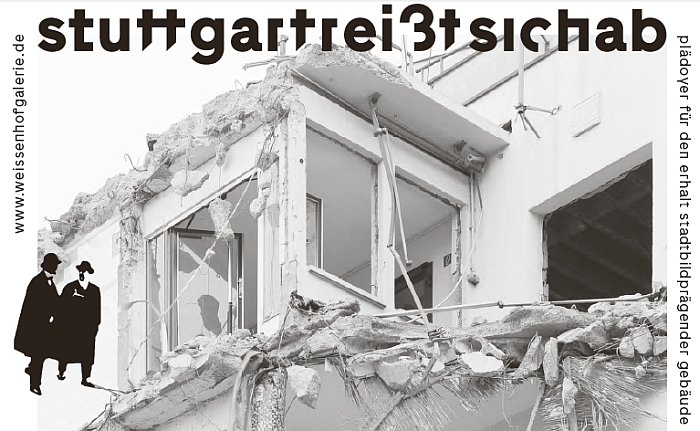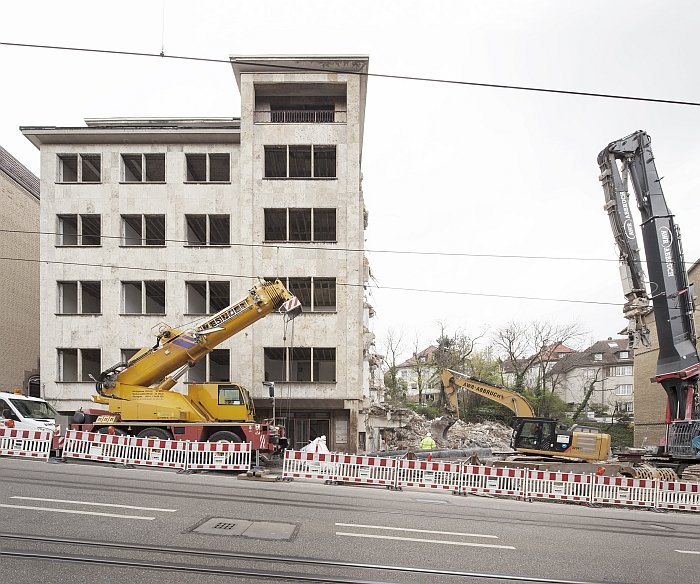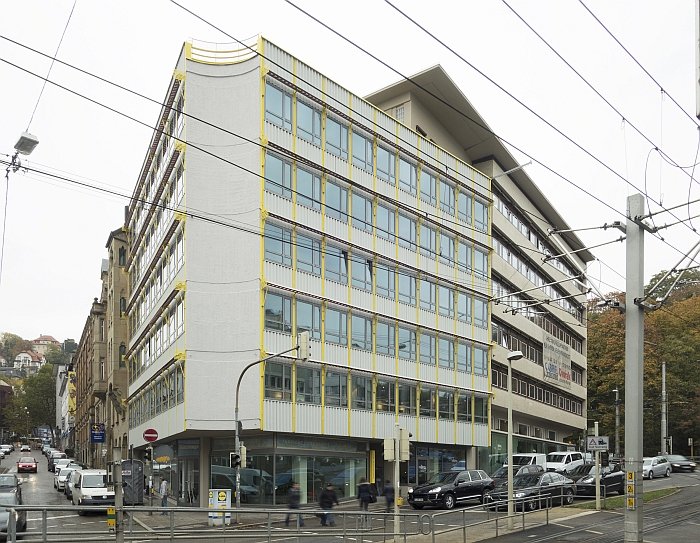Cities grow, mutate, evolve, a process which, as with human development, is rarely straightforward, rarely occurs without sacrifice and/or leaving one or the other scar. Physical as well as emotional. With the exhibition Stuttgart reißt sich ab - Stuttgart Demolishes Itself - the Architekturgalerie am Weissenhof aim to explore the nature of post-war urban development in Stuttgart, and to present what they refer to as a "Plea for the preservation of cityscape defining buildings"
Co-curated by architect Claudia Betke and Wilfried Dechau, architect and former editor of the German architecture magazine "db – deutsche bauzeitung", Stuttgart reißt sich ab presents via large format photographs by Wilfried Dechau and Wolfram Janzer examples of buildings that have either been demolished in recent years, or which have been saved, and when then largely on account of public initiatives and popular protest, while a city plan by Claudia Betke provides for a clear overview of those, or at least most of those, buildings lost/saved/endangered and as such neatly highlights the changes, and for all the extent and chronology of the changes, that have occurred in Stuttgart since the war.

Cities grow, mutate, evolve, yet owing to its geographic position Stuttgart is a city with only limited room to expand; in effect the city sits in a hollow, hemmed in, more or less, on all sides by gently rolling hills. Scenic, if impractical in an urban development context. Consequently urban growth in Stuttgart can largely only function through change, and in Stuttgart, as everywhere, urban change is a controversial, and highly emotional, subject. The arguments surrounding the construction of Le Centre Pompidou in Paris and the associated redevelopment of the surrounding area perhaps demonstrating such more eloquently than any other "recent" example.
Much of the current change in Stuttgart is occurring in context of the so-called Stuttgart 21 rail project, a project which will see Stuttgart Central Station relocated underground, thus allowing for redevelopment of the existing site. And a project more controversial and emotional than most, and one which is resulting in change with a tempo all of its own, and thus one who's shadow hovers over most discussions surrounding contemporary urban development in Stuttgart. The recent announcement that the project will be finished later, and at more expense, than initially planned only serving to stoke the slowly burning fires.
The nature of urban change in Stuttgart is further defined by the fact that, as co-curator Claudia Betke explains, "when an investor in Stuttgart can prove that it is uneconomic to maintain a building, it can be demolished". And that regardless of any listed building status it may enjoy. A state of affairs neatly demonstrated by Egon Eiermann's highly controversial decision in 1956 to demolish Erich Mendelsohn's Schocken department store in order to build a new department store. According to Eiermann the existing structure was "substandard" and bringing it up to contemporary standards would have been uneconomic. Eiermann's opponents argued otherwise. Unsuccessfully. The decision to demolish Mendelsohn's building not only being one of the classic examples of the brutal nature of urban change in Stuttgart, but remains a very painful and prevailing wound for many in the city. More recent examples of buildings demolished include the Amerika-Haus/Filmhaus, the former IHK headquarters and the former Interior Ministry building in the Dorotheenstrasse. The question of what listing status a building enjoys is in itself further complicated by the fact that in no Stuttgart official list of protected buildings has been published since 2008. Whereas in other major German cities such as, for example, Berlin, Cologne or Frankfurt the lists of protected buildings are online and freely available, in Stuttgart access is restricted by the Data Protection Act and only those who can present a justifiable interest receive information. For one building. A casual interest in the list in general not sufficing. As part of the preparations for the exhibition Claudia Betke made use Freedom of Information laws, and a good deal of steely tenacity, to tease a copy of the current list from Stuttgart Council. A current list which of course will invariably become outdated as and when changes occur. A state of affairs which raises the obvious question, if information about what buildings or parts of buildings are listed, and for all why they are listed, isn’t freely available, how can one have an open and informed debate about how change is being planned and realised? Similarly, if no one knows how and why buildings are being listed and de-listed, how can one have an open and informed debate about local planning politics? And that in a city such as Stuttgart which is reliant on urban change for urban growth. And where Stuttgart 21 has, as it were, raised the emotional temperature.

Cities grow, mutate, evolve but that needn't mean demolition, and correspondingly Stuttgart reißt sich ab also presents examples of buildings once earmarked for, or at least threatened by, demolition, but which have been "saved" and given a new lease of life and/or a new position in the community, a list which includes buildings as varied as, for example, the Art Nouveau Markthalle by Martin Elsaesser, the so-called LOBA-Haus by Rolf Gutbrod and Paul Stohrer and, and perhaps as the most surprising example, the Weissenhofsiedlung; arguably one of the most important documents of inter-war functionalist architecture, and an estate which stands as representative of Stuttgart's and Baden-Württemberg's role in the development of contemporary ideas in architecture and design, not only because the event was staged in Stuttgart but because the majority of the suppliers and contractors were local. Yet an estate whose future is not 100% guaranteed. Although one must add that the situation is somewhat complicated by the fact the estate is owned by the German State, and so not directly under Stuttgart's control. No, the Weissenhofsiedlung houses aren't the most spacious, or the best insulted, in Europe, and so yes, one could argue that demolishing them and building newer, more spacious, better insulated buildings would represent progress: but the Weissenhof Houses exist, are important historical monuments, provide an important contemporary function, and are part of a coherent local community; and demolishing and rebuilding has not only cultural and social consequences, but also environmental, As we noted in a previous post, "we don’t believe every building is automatically worth keeping, just because it is from architect X or Y. Where a building is no longer required or is no longer capable of fulfilling its intended function, it must make way for a construction that can. Which of course doesn’t mean automatically tearing down old buildings. As a first step must surely come the question if one can’t make alterations. Adapt the building to its new function and/or new technological standards." And as the Architekturgalerie's recent presentation of regeneration projects by the Paris based studio Druot, Lacaton & Vassal beautifully demonstrated, in certain cases renovation can be the more sensible economic, social and environmental decision.

Cities grow, mutate, evolve and in the course of such the fabric of the city changes. And not just the physical fabric, the spiritual, social, cultural fabric changes. Gradual, organic changes are part of that process and are accordingly effortlessly absorbed; abrupt, forced changes less so. Where housing, cultural institutions or established business cede to commerce, offices and luxury apartments relationships, realities and social structures change. Or indeed when established inner city districts cede to cultural institutions, as in the aforementioned case of Le Centre Pompidou.
Ecologists have slowly learned that intricate networks support the functioning of ecosystems; and similarly urban spaces prosper or fail depending on the nature and strength of their inherent networks. Consequently, the secret, if not intention, must always be that through urban change no group is advantaged more than others, that all benefit from the changes, and that the changes encourage and enhance the balance of a community and thus the stability of the networks.
A deliberately politically positioned exhibition, Stuttgart reißt sich ab argues that in Stuttgart such is not the case, that in Stuttgart the interests of finance and commerce take priority over all others, that through the developments not only are buildings being demolished without proper consideration of their relevance to and wider function in the city, but that affordable housing and space for culture and the creative industries is vanishing, and that with the tacit support of the authorities.
Obviously you don't have to agree with that position. The exhibition presents the curators' arguments and invites discussion. In which context an important component of the exhibition concept is the opening lecture from the architecture historian Frank R. Werner and subsequent discussion with, amongst others, Herbert Medek, Head of the Stuttgart City Council's Historic Building Protection Authority
Urban planning is something which affects us all, something which thus should interest us all, yet is something that we all too often are all to happy to entrust to others. Stuttgart reißt sich ab neatly explains why everyone should take an active interest in developments in their communities, in the way they grow, mutate and evolve.
Stuttgart reißt sich ab. Plea for the Preservation of Cityscape Defining Buildings opens at the Architekturgalerie am Weissenhof, Am Weissenhof 30, 70191 Stuttgart on Wednesday June 15th and runs until Sunday September 18th.
The opening lecture and discussion take place at 7pm on 15.06 in the Vortragssaal Neu-Bau 2, Der Staatlichen Akademie der Bildende Künste Stuttgart, Am Weissenhof 1, 70191 Stuttgart. And in German.
Full details, including information on the accompanying fringe programme can be found at http://weissenhofgalerie.de/